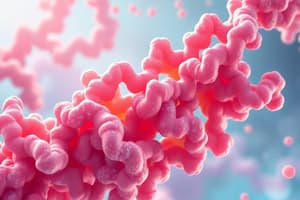Podcast
Questions and Answers
During periods of rapid growth, such as pregnancy, the body is typically in:
During periods of rapid growth, such as pregnancy, the body is typically in:
- Nitrogen equilibrium, where intake equals excretion.
- Positive nitrogen balance, indicating protein synthesis exceeding breakdown. (correct)
- Negative nitrogen balance, indicating protein breakdown exceeding synthesis.
- Ammonia toxicity due to excessive nitrogen excretion.
Which type of protein structure is characterized by the specific sequence of amino acids?
Which type of protein structure is characterized by the specific sequence of amino acids?
- Tertiary structure
- Primary structure (correct)
- Secondary structure
- Quaternary structure
Folding patterns like alpha-helices and beta-sheets are associated with which level of protein structure?
Folding patterns like alpha-helices and beta-sheets are associated with which level of protein structure?
- Quaternary
- Secondary (correct)
- Primary
- Tertiary
What is the process called that involves the unfolding and loss of a protein's three-dimensional structure?
What is the process called that involves the unfolding and loss of a protein's three-dimensional structure?
Which of the following is an example of a transport protein?
Which of the following is an example of a transport protein?
A diet that lacks sufficient amounts of lysine, threonine, and tryptophan would lead to:
A diet that lacks sufficient amounts of lysine, threonine, and tryptophan would lead to:
Which of the following food combinations represents complementary proteins?
Which of the following food combinations represents complementary proteins?
An individual consuming a diet severely deficient in protein would most likely exhibit:
An individual consuming a diet severely deficient in protein would most likely exhibit:
Which government program is designed to provide food assistance and nutrition education to pregnant women, new mothers, infants, and young children?
Which government program is designed to provide food assistance and nutrition education to pregnant women, new mothers, infants, and young children?
Which situation best exemplifies food insecurity?
Which situation best exemplifies food insecurity?
A family that consistently runs out of food before the end of the month due to financial constraints is experiencing:
A family that consistently runs out of food before the end of the month due to financial constraints is experiencing:
What is the primary purpose of the Supplemental Nutrition Assistance Program (SNAP)?
What is the primary purpose of the Supplemental Nutrition Assistance Program (SNAP)?
Which scenario represents a risk of chemical contamination in food?
Which scenario represents a risk of chemical contamination in food?
Why is it important to avoid keeping food in the temperature danger zone (40°F - 140°F)?
Why is it important to avoid keeping food in the temperature danger zone (40°F - 140°F)?
What is the primary purpose of food irradiation?
What is the primary purpose of food irradiation?
Which practice is most effective in preventing cross-contamination?
Which practice is most effective in preventing cross-contamination?
Which of the following is a key factor that microorganisms need to reproduce?
Which of the following is a key factor that microorganisms need to reproduce?
If you observe mold growing on a loaf of bread, what type of contamination is present?
If you observe mold growing on a loaf of bread, what type of contamination is present?
What is the approximate energy content of alcohol?
What is the approximate energy content of alcohol?
In which organ is alcohol primarily metabolized?
In which organ is alcohol primarily metabolized?
As alcohol tolerance develops, what is a common misconception?
As alcohol tolerance develops, what is a common misconception?
Which factor has the LEAST effect on a person's Blood Alcohol Concentration (BAC)?
Which factor has the LEAST effect on a person's Blood Alcohol Concentration (BAC)?
Which of the following is a potential health consequence of chronic, excessive alcohol consumption?
Which of the following is a potential health consequence of chronic, excessive alcohol consumption?
Which of the following statements about moderate alcohol consumption is most accurate?
Which of the following statements about moderate alcohol consumption is most accurate?
During digestion, proteins are broken down into:
During digestion, proteins are broken down into:
If an individual consumes excessive protein beyond their body's needs, the excess is:
If an individual consumes excessive protein beyond their body's needs, the excess is:
What condition can arise from a prolonged deficiency in protein intake?
What condition can arise from a prolonged deficiency in protein intake?
Why is understanding the four levels of protein structure important?
Why is understanding the four levels of protein structure important?
In protein synthesis, what is the role of translation?
In protein synthesis, what is the role of translation?
What is the most significant implication of protein denaturation?
What is the most significant implication of protein denaturation?
Flashcards
Amino Acids
Amino Acids
Building blocks of proteins; 20 types, 9 essential (diet), 11 non-essential (body can synthesize).
Essential Amino Acids
Essential Amino Acids
Amino acids the body cannot produce and must be obtained from the diet.
Non-Essential Amino Acids
Non-Essential Amino Acids
Amino acids the body can synthesize from other amino acids or metabolic intermediates.
Primary Structure
Primary Structure
Signup and view all the flashcards
Secondary Structure
Secondary Structure
Signup and view all the flashcards
Tertiary Structure
Tertiary Structure
Signup and view all the flashcards
Quaternary Structure
Quaternary Structure
Signup and view all the flashcards
Protein Denaturation
Protein Denaturation
Signup and view all the flashcards
Protein Synthesis
Protein Synthesis
Signup and view all the flashcards
Enzymes
Enzymes
Signup and view all the flashcards
Hormones
Hormones
Signup and view all the flashcards
Structural Proteins
Structural Proteins
Signup and view all the flashcards
Transport Proteins
Transport Proteins
Signup and view all the flashcards
Antibodies
Antibodies
Signup and view all the flashcards
Muscle Contraction
Muscle Contraction
Signup and view all the flashcards
RDA for Protein
RDA for Protein
Signup and view all the flashcards
AMDR for Protein
AMDR for Protein
Signup and view all the flashcards
Positive Nitrogen Balance
Positive Nitrogen Balance
Signup and view all the flashcards
Negative Nitrogen Balance
Negative Nitrogen Balance
Signup and view all the flashcards
Complementary Proteins
Complementary Proteins
Signup and view all the flashcards
Food Security
Food Security
Signup and view all the flashcards
Hunger
Hunger
Signup and view all the flashcards
Food Insecurity
Food Insecurity
Signup and view all the flashcards
Biological Contamination
Biological Contamination
Signup and view all the flashcards
Chemical Contamination
Chemical Contamination
Signup and view all the flashcards
Physical Contamination
Physical Contamination
Signup and view all the flashcards
Danger Zone
Danger Zone
Signup and view all the flashcards
Food Irradiation
Food Irradiation
Signup and view all the flashcards
Clean
Clean
Signup and view all the flashcards
Separate
Separate
Signup and view all the flashcards
Signup and view all the flashcards
Study Notes
Protein: Structure and Function
- Amino acids are the building blocks of proteins; there are 20 types.
- Nine essential amino acids must be obtained from the diet.
- Eleven non-essential amino acids can be synthesized by the body.
- Essential amino acids include histidine, isoleucine, leucine, lysine, methionine, phenylalanine, threonine, tryptophan, and valine.
- Non-essential amino acids include alanine, arginine, asparagine, aspartic acid, cysteine, glutamic acid, glutamine, glycine, proline, serine, and tyrosine.
- Proteins have four levels of structure: primary, secondary, tertiary, and quaternary.
- Primary structure refers to the linear sequence of amino acids.
- Secondary structure involves local folding patterns like alpha-helices and beta-sheets, stabilized by hydrogen bonds.
- Tertiary structure is the overall 3D arrangement of a polypeptide chain, determined by interactions between amino acid side chains.
- Quaternary structure involves the arrangement of multiple polypeptide chains in a protein complex.
- A protein's specific 3D shape is crucial for its function.
- Denaturation alters protein shape and function.
- Protein denaturation involves unfolding and loss of 3D structure, caused by heat, pH changes, or chemicals.
- Protein denaturation is important in cooking, as it makes proteins more digestible, and in digestion, as it breaks down proteins into amino acids.
- Protein synthesis involves transcription (DNA to mRNA) and translation (mRNA to protein).
- Protein functions include serving as enzymes, hormones, structural proteins, transport proteins, and antibodies, and contributing to muscle contraction.
- The RDA for protein is 0.8 grams per kilogram of body weight.
- The AMDR for protein is 10-35% of total daily calories.
- Recommendations can vary based on age, activity level, and health status.
- Positive nitrogen balance indicates protein synthesis is greater than breakdown.
- Negative nitrogen balance indicates protein breakdown is greater than synthesis.
- Complementary proteins combine incomplete proteins to obtain all essential amino acids.
- Examples of complementary proteins include rice and beans, or lentils and corn.
Food Insecurity and Malnutrition
- Food security means access by all people at all times to enough food for an active, healthy life.
- This includes availability, access, utilization, and stability of food supply.
- Hunger is a physiological sensation indicating a need for food.
- Food insecurity means being without reliable access to a sufficient quantity of affordable, nutritious food.
- Groups at risk include those experiencing poverty, unemployment, lack of transportation, and chronic health conditions.
- Children, pregnant women, and the elderly are particularly vulnerable.
- Government programs combat food insecurity.
- The Supplemental Nutrition Assistance Program (SNAP) provides food assistance benefits to low-income individuals and families.
- The National School Lunch Program provides free or reduced-price lunches to eligible students.
- The Special Supplemental Nutrition Program for Women, Infants, and Children (WIC) provides food assistance and nutrition education to pregnant women, new mothers, infants, and young children.
- The Commodity Supplemental Food Program (CSFP) provides monthly supplemental food packages to low-income seniors.
Food Safety and Contamination
- Food contamination is the presence of harmful substances in food.
- Types of contamination are: biological, chemical, or physical.
- Biological contamination includes bacteria, viruses, parasites, and fungi.
- Chemical contamination includes pesticides, herbicides, heavy metals, and cleaning agents.
- Physical contamination includes glass, metal, plastic, hair, and insects.
- Causes of contamination include improper food handling, inadequate cooking, cross-contamination, contaminated water, and unsafe food storage.
- Microorganism reproduction requires specific conditions like temperature, moisture, nutrients, time, pH, and oxygen.
- The "danger zone" is between 40°F and 140°F (4°C and 60°C), where bacteria multiply rapidly.
- Food irradiation uses ionizing radiation to kill microorganisms and extend shelf life and does not make food radioactive.
- Consumer-level techniques involves washing hands, surfaces, and utensils thoroughly. Separating raw and cooked foods to prevent cross-contamination. Cooking foods to safe internal temperatures and refrigerating perishable foods promptly.
Alcohol: Production, Metabolism, and Effects
- Alcohol is produced through fermentation, where yeast converts sugars into ethanol and carbon dioxide.
- Alcohol is absorbed rapidly from the stomach and small intestine.
- It is primarily metabolized in the liver by alcohol dehydrogenase.
- Alcohol provides 7 calories per gram.
- Alcohol can contribute significantly to overall energy intake.
- Blood Alcohol Concentration (BAC) is affected by factors such as the amount of alcohol consumed, body weight, and gender.
- Tolerance develops over time with regular alcohol consumption, but does not reduce the harmful effects of alcohol.
- Alcohol abuse can lead to liver disease, heart disease, cancer, neurological disorders, and mental health issues.
- Moderate alcohol consumption has been associated with a reduced risk of cardiovascular disease in some studies.
Studying That Suits You
Use AI to generate personalized quizzes and flashcards to suit your learning preferences.




